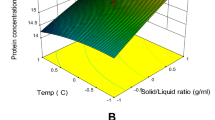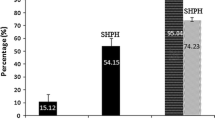Abstract
Snow crab (Chionoecetes opilio) by-products are a rich source of biomolecules, such as lipids, proteins, and chitin, which have not been extensively investigated. This study aims to identify antibacterial peptides to enhance the value of C. opilio by-products. After hydrolysis of different component parts using Protamex®, and concentration by solid-phase extraction, the resulting fractions were tested for antibacterial activity against Escherichia coli, Listeria innocua, and Vibrio parahaemolyticus. Hepatopancreas was the only tissue to display antibacterial activity detected using this protocol. Four fractions obtained with and without enzymatic hydrolysis of hepatopancreas followed by SPE C18 fractionation and elution with 50 and 80% acetonitrile demonstrated bacteriostatic activity against L. innocua HPB13, from concentrations of 0.30 to 43.05 mg/mL of peptides/proteins. Eleven peptides sharing at least 80% amino acid homology with four antimicrobial peptides were identified by mass spectrometry. Two peptides had homology to crustin-like and yellowfin tuna GAPDH antimicrobial peptides belonging to the marine organisms Penaeus monodon and Thunnus albacares, respectively. Other peptide sequence homologies were also identified: Odorranain-C7 from the frog Odorrana grahami and a predicted antibacterial peptide in the Asian ladybeetle Harmonia axyridis. These active peptides may represent a novel group of bioactive peptides deserving further investigation as food preservatives.




Similar content being viewed by others
References
MAPAQ (2015) Monographie de l’industrie du crabe des neiges
DFO (2015) Snow crab. http://www.dfo-mpo.gc.ca/fm-gp/sustainable-durable/fisheries-peches/snow-crab-eng.htm. [Accessed: 01-Apr-2017]
Carbonneau ME (2013) Coproduits de crabe des neiges. Merinov. https://www.google.ca/url?sa=t&rct=j&q=&esrc=s&source=web&cd=1&ved=0ahUKEwievZWn08vZAhUL0IMKHSi0CNoQFggpMAA&url=https%253A%252F%252Fwww.merinov.ca%252Ffr%252Fpubli%253Ftask%253Dcallelement%2526format%253Draw%2526item_id%253D739%2526element%253D5683814e-953d-40a2-8d2a-15d5ece9d966%25. [Accessed: 01-Feb-2018]
Bouazza A (2009) Purification, caractérisation et etude des proprieties immunostumulantes de l’hémocyanine de crabe des neiges, Chinoecetes Opilio. Dissertation, Laval University
Lafarga T, Hayes M (2017) Bioactive protein hydrolysates in the functional food ingredient industry: overcoming current challenges. Food Rev Int 33:217–246. https://doi.org/10.1080/87559129.2016.1175013
Beaulieu L, Thibodeau J, Bryl P, Carbonneau ME (2009) Characterization of enzymatic hydrolyzed snow crab (Chionoecetes opilio) by-product fractions: a source of high-valued biomolecules. Bioresour Technol 100:3332–3342. https://doi.org/10.1016/j.biortech.2009.01.073
Jiao G, Yu G, Zhang J, Ewart HS (2011) Chemical structures and bioactivities of sulfated polysaccharides from marine algae. Mar Drugs 9:196–233. https://doi.org/10.3390/md9020196
Sanina NM, Velansky PV, Kostetsky EY (2016) The thermotropic behavior and fatty radical composition of major phospholipids of the tanner crab Chionoecetes bairdi Rathbun, 1924. Russ J Mar Biol 42:81–86. https://doi.org/10.1134/S1063074016010156
Matos J, Cardoso C, Bandarra NM, Afonso C (2017) Microalgae as a healthy ingredient for functional food: a review. Food Funct 8:2672–2685. https://doi.org/10.1039/C7FO00409E
Ng TB, Cheung RCF, Wong JH, Bekhit AA, Bekhit AED (2015) Antibacterial products of marine organisms. Appl Microbiol Biotechnol 99:4145–4173. https://doi.org/10.1007/s00253-015-6553-x
Tincu JA, Taylor SW (2004) Antimicrobial peptides from marine invertebrates. Antimicrob Agents Chemother 48:3645–3654. https://doi.org/10.1128/AAC.48.10.3645-3654.2004
Otero-González AJ, Magalhães BS, Garcia-Villarino M, López-Abarrategui C, Sousa DA, Dias SC, Franco OL (2010) Antimicrobial peptides from marine invertebrates as a new frontier for microbial infection control. FASEB J 24:1320–1334. https://doi.org/10.1096/fj.09-143388
Lahl WJ (1994) Enzymatic production of protein by hydrolysates for food use. Food Sci 48:68–71
Tam JP, Lu YA, Yang JL (2000) Marked increase in membranolytic selectivity of novel cyclic tachyplesins constrained with an antiparallel two-strand cystine knot framework. Biochem Biophys Res Commun 267:783–790. https://doi.org/10.1006/bbrc.1999.2035
Miyata T, Tokunaga F, Yoneya T, Yoshikawa K, Iwanaga S, Niwa M, Takao T, Shimonishi Y (1989) Antimicrobial peptides, isolated from horseshoe crab hemocytes, tachyplesin II, and polyphemusins I and II: chemical structures and biological activity. J Biochem 106:663–668. https://doi.org/10.1093/oxfordjournals.jbchem.a122913
Antony SP, Singh ISB, Sudheer NS, Vrinda S, Priyaja P, Philip R (2011) Molecular characterization of a crustin-like antimicrobial peptide in the giant tiger shrimp, Penaeus monodon, and its expression profile in response to various immunostimulants and challenge with WSSV. Immunobiology 216:184–194. https://doi.org/10.1016/j.imbio.2010.05.030
Sruthy KS, Chaithanya ER, Sathyan N, Nair A, Antony SP, Bright Singh IS, Philip R (2015) Molecular characterization and phylogenetic analysis of novel isoform of anti-lipopolysaccharide factor from the Mantis shrimp, Miyakea nepa. Probiotics Antimicrob Proteins 7:275–283. https://doi.org/10.1007/s12602-015-9198-2
Lee SY, Lee BL, Soderhall K (2003) Processing of an antibacterial peptide from hemocyanin of the freshwater crayfish Pacifastacus leniusculus. J Biol Chem 278:7927–7933. https://doi.org/10.1074/jbc.M209239200
Munoz M, Vandenbulcke F, Garnier J, Gueguen Y, Bulet P, Saulnier D, Bachère E (2004) Involvement of penaeidins in defense reactions of the shrimp Litopenaeus stylirostris to a pathogenic vibrio. Cell Mol Life Sci 61:961–972. https://doi.org/10.1007/s00018-003-3441-9
Stensvag K, Haug T, Sperstad SV et al (2008) Arasin 1, a proline-arginine-rich antimicrobial peptide isolated from the spider crab, Hyas araneus. Dev Comp Immunol 32:275–285. https://doi.org/10.1016/j.dci.2007.06.002
Sperstad SV, Haug T, Vasskog T, Stensvag K (2009) Hyastatin, a glycine-rich multi-domain antimicrobial peptide isolated from the spider crab (Hyas araneus) hemocytes. Mol Immunol 46:2604–2612. https://doi.org/10.1016/j.molimm.2009.05.002
Relf JM, Chisholm JRS, Kemp GD, Smith VJ (1999) Purification and characterization of a cysteine-rich 11.5-kDa antibacterial protein from the granular haemocytes of the shore crab, Carcinus maenas. Eur J Biochem 264:350–357. https://doi.org/10.1046/j.1432-1327.1999.00607.x
Noga EJ, Stone KL, Wood A, Gordon WL, Robinette D (2011) Primary structure and cellular localization of callinectin, an antimicrobial peptide from the blue crab. Dev Comp Immunol 35:409–415. https://doi.org/10.1016/j.dci.2010.11.015
Beaulieu L, Thibodeau J, Desbiens M, Saint-Louis R, Zatylny-Gaudin C, Thibault S (2010) Evidence of antibacterial activities in peptide fractions originating from snow crab (Chionoecetes opilio) by-products. Probiotics Antimicrob Proteins 2:197–209. https://doi.org/10.1007/s12602-010-9043-6
Gaillard M, Bernatchez L, Tremblay R, Audet C (2015) Regional variation in energy storage strategies in American glass eels from Eastern Canada. Comp Biochem Physiol A Mol Integr Physiol 188:87–95. https://doi.org/10.1016/j.cbpa.2015.06.019
Ebeling ME (1968) The Dumas method for nitrogen in feeds. J Assoc Off Anal Chem 51:766–770
Spinelli J, Lehman L, Wieg D (1974) Composition, processing, and utilization of red crab (Pleuroncodes planipes) as an aquacultural feed ingredient. J Fish Res Board Can 31:1025–1029. https://doi.org/10.1139/f74-115
Hamed I, Ozogul F, Regenstein JM (2016) Industrial applications of crustacean by-products (chitin, chitosan, and chitooligosaccharides): a review. Trends Food Sci Technol 48:40–50. https://doi.org/10.1016/j.tifs.2015.11.007
AOAC, Official Methods of Analysis (1990) Arlington, Virginia, USA
Robert M, Zatylny-Gaudin C, Fournier V, Corre E, Le Corguillé G, Bernay B, Henry J (2014) Transcriptomic and peptidomic analysis of protein hydrolysates from the white shrimp (L. vannamei). J Biotechnol 186:30–37. https://doi.org/10.1016/j.jbiotec.2014.06.020
Church FC, Swaisgood HE, Porter DH, Catignani GL (1983) Spectrophotometric assay using o-phthaldialdehyde for determination of proteolysis in milk and isolated milk proteins. J Dairy Sci 66:1219–1227. https://doi.org/10.3168/jds.S0022-0302(83)81926-2
Doyen A, Saucier L, Beaulieu L, Pouliot Y, Bazinet L (2012) Electroseparation of an antibacterial peptide fraction from snow crab by-products hydrolysate by electrodialysis with ultrafiltration membranes. Food Chem 132:1177–1184. https://doi.org/10.1016/j.foodchem.2011.11.059
Sharpe AN, Kilsby DC (1971) A rapid, inexpensive bacterial count technique using agar droplets. J Appl Bacteriol 34:435–440. https://doi.org/10.1111/j.1365-2672.1971.tb02303.x
Beaulieu L, Bondu S, Doiron K, Rioux LE, Turgeon SL (2015) Characterization of antibacterial activity from protein hydrolysates of the macroalga Saccharina longicruris and identification of peptides implied in bioactivity. J Funct Foods 17:685–697. https://doi.org/10.1016/j.jff.2015.06.026
Adeyeye EI (2002) Determination of the chemical composition of the nutritionally valuable parts of male and female common west African fresh water crab Sudananautes africanus africanus. Int J Food Sci Nutr 53:189–196. https://doi.org/10.1080/09637480220132805
Skonberg DI, Perkins BL (2002) Nutrient composition of green crab (Carcinus maenus) leg meat and claw meat. Food Chem 77:401–404. https://doi.org/10.1016/S0308-8146(01)00364-8
Shahidi F, Synowiecki J (1991) Isolation and characterization of nutrients and value-added products from snow crab (Chionoecetes opilio) and shrimp (Pandalus borealis) processing discards. J Agric Food Chem 39:1527–1532. https://doi.org/10.1021/jf00008a032
Carbonneau ME (2013) Coproduits du crabe commun, carapaces. Merinov. http://www.merinov.ca/fr/app-publication/item/fiche-biomasse-marine-sous-valorisee-crabe-commun-carapace. [Accessed: 01-Feb-2018]
Crespo MOP, Martínez MV, Hernández JL, Lage Yusty MA (2006) High-performance liquid chromatographic determination of chitin in the snow crab, Chionoecetes opilio. J Chromatogr 1116:189–192. https://doi.org/10.1016/j.chroma.2006.03.068
DFO (2016) Snow crab. http://www.dfo-mpo.gc.ca/species-especes/profiles-profils/snow-crab-crabe-neiges-atl-eng.html. [Accessed: 24-May-2017]
Joffe I, Hepburn HR, Nelson KJ, Green N (1975) Mechanical properties of a crustacean exoskeleton. Comp Biochem Physiol Physiol 50:545–549. https://doi.org/10.1016/0300-9629(75)90312-6
Hepburn HR, Joffe I, Green N, Nelson KJ (1975) Mechanical properties of a crab shell. Comp Biochem Physiol 50:551–554
Taylor HH (1990) Pressure-flow characteristics of crab gills: implications for regulation of hemolymph pressure. Physiol Biochem Zool 63:72–89. https://doi.org/10.1086/physzool.63.1.30158154
Wheeler K, Shields JD, Taylor DM (2007) Pathology of hematodinium infections in snow crabs (Chionoecetes opilio) from Newfoundland, Canada. J Invertebr Pathol 95:93–100. https://doi.org/10.1016/j.jip.2007.01.002
You L, Zhao M, Cui C, Zhao H, Yang B (2009) Effect of degree of hydrolysis on the antioxidant activity of loach (Misgurnus anguillicaudatus) protein hydrolysates. Innov Food Sci Emerg Technol 10:235–240. https://doi.org/10.1016/j.ifset.2008.08.007
Mori K, Stewart JE (1978) The hemolymph bactericidin of American lobster (Homarus americanus): adsorption and activation. J Fish Res Board Canada 35:1504–1507. https://doi.org/10.1139/f78-238
Hajirasouli M, Pizooki J (2014) Antimicrobial potential of hemolymph and hepatopancreas of Portunus segnis crabs. Int J Pharm Pharm Sci 6:6–8
Kushibiki T, Kamiya M, Aizawa T, Kumaki Y, Kikukawa T, Mizuguchi M, Demura M, Kawabata SI, Kawano K (2014) Interaction between tachyplesin I, an antimicrobial peptide derived from horseshoe crab, and lipopolysaccharide. BBA—Proteins Proteomics 1844:527–534. https://doi.org/10.1016/j.bbapap.2013.12.017
Destoumieux D, Bulet P, Loew D, van Dorsselaer A, Rodriguez J, Bachère E (1997) Penaeidins, a new family of antimicrobial peptides isolated from the shrimp Penaeus vannamei (Decapoda). J Biol Chem 272:28398–28406. https://doi.org/10.1074/jbc.272.45.28398
Schnapp D, Kemp GD, Smith VJ (1996) Purification and characterization of a proline-rich antibacterial peptide, with sequence similarity to bactenecin-7, from the haemocytes of the shore crab, Carcinus maenas. Eur J Biochem 240:532–539. https://doi.org/10.1111/j.1432-1033.1996.0532h.x
Pankey GA, Sabath LD (2004) Clinical relevance of bacteriostatic versus bactericidal mechanisms of action in the treatment of Gram-positive bacterial infections. Clin Infect Dis 38:864–870. https://doi.org/10.1086/381972
Vilcinskas A, Mukherjee K, Vogel H (2013) Expansion of the antimicrobial peptide repertoire in the invasive ladybird Harmonia axyridis. Proc Biol Sci 280:2012–2113. https://doi.org/10.1098/rspb.2012.2113.
Smith VJ, Fernandes JMO, Kemp GD, Hauton C (2008) Crustins: enigmatic WAP domain-containing antibacterial proteins from crustaceans. Dev Comp Immunol 32:758–772. https://doi.org/10.1016/j.dci.2007.12.002
Jiravanichpaisal P, Lee SY, Kim YA, Andrén T, Soderhall I (2007) Antibacterial peptides in hemocytes and hematopoietic tissue from freshwater crayfish Pacifastacus leniusculus: characterization and expression pattern. Dev Comp Immunol 31:441–455. https://doi.org/10.1016/j.dci.2006.08.002
Oberdorster E, Rittschof D, Mcclellan-Green P (1998) Induction of cytochrome P450 3A and heat shock protein by tributyltin in blue crab, Callinectes sapidus. Aquat Toxicol 41:83–100. https://doi.org/10.1016/S0166-445X(97)00067-2
Li J, Xueqing X, Chunhua X et al (2007) Anti-infection peptidomics of amphibian skin. Mol Cell Proteomics 6:882–894. https://doi.org/10.1074/mcp.M600334-MCP200
Seo JK, Lee MJ, Go HJ, Park TH, Park NG (2012) Purification and characterization of YFGAP, a GAPDH-related novel antimicrobial peptide, from the skin of yellowfin tuna, Thunnus albacares. Fish Shellfish Immunol 33:743–752. https://doi.org/10.1016/j.fsi.2012.06.023
Dhar AK, Dettori A, Roux MM, Klimpel AR, Reid B (2003) Identification of differentially expressed genes in shrimp (Penaeus stylirostris) infected with White spot syndrome virus by cDNA microarrays. Arch Virol 148:2381–2396. https://doi.org/10.1007/s00705-003-0172-z
Dhar AK, Bowers RM, Licon KS, Veazey G, Read B (2009) Validation of reference genes for quantitative measurement of immune gene expression in shrimp. Mol Immunol 46:1688–1695. https://doi.org/10.1016/j.molimm.2009.02.020
Lüders T, Birkemo GA, Fimland G, Nissen-Meyer J, Nes IF (2003) Strong synergy between a eukaryotic antimicrobial peptide and bacteriocins from lactic acid bacteria. Appl Environ Microbiol 69:1797–1799. https://doi.org/10.1128/AEM.69.3.1797-1799.2003
Acknowledgments
The authors wish to thank Réjean Tremblay for welcoming us in his laboratory (ISMER-UQAR, QC, Canada) and for snow crab dissection; Jean-Bruno Nadalini (ISMER-UQAR, QC, Canada), Diane Gagnon (Université Laval, QC, Canada), and Marine Béguin (Université Laval, QC, Canada) for their technical expertise. The authors would also like to thank the Natural Sciences and Engineering Research Council of Canada (NSERC) for their financial support (NSERC discovery grant; RGPIN/327203-2011).
Author information
Authors and Affiliations
Corresponding author
Ethics declarations
Conflict of Interest
The authors declare that they have no conflict of interest.
Rights and permissions
About this article
Cite this article
El Menif, E., Offret, C., Labrie, S. et al. Identification of Peptides Implicated in Antibacterial Activity of Snow Crab Hepatopancreas Hydrolysates by a Bioassay-Guided Fractionation Approach Combined with Mass Spectrometry. Probiotics & Antimicro. Prot. 11, 1023–1033 (2019). https://doi.org/10.1007/s12602-018-9484-x
Published:
Issue Date:
DOI: https://doi.org/10.1007/s12602-018-9484-x




